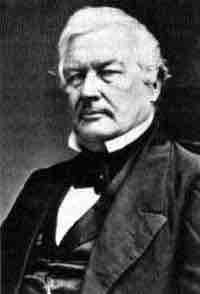Whigs and the Slavery Issue: The Compromise of 1850
A primary conflict between Democrats and Whigs revolved around California's admission to the union as a free state, which would upset the sectional balance of power between free and slave states in Congress. The result was an arduous legislative battle between Southern and Northern representatives, with the South arguing that Congress and the states did not have the authority to legislate against the territorial expansion of slavery. Realizing that this sectional divide could split the country, Whigs and Democrats came to a compromise that they hoped would prevent secession. The ensuing Compromise of 1850 allowed California to be admitted as a free state, but strengthened the Fugitive Slave Law and made no provisions for how other territories could address the slavery issue.
The Whigs were unable to effectively address the slavery issue after 1850. Nearly all of their Southern members owned slaves, while the Northeastern Whigs were largely businessmen who sought national unity and a strong national market but cared little about the institution of slavery. There was no compromise that could keep the Whigs united, which contributed to the party's demise in the 1850s.

President Millard Fillmore
Millard Fillmore, the last Whig President.
Demise of the Whigs: 1852–1856
The election of 1852 marked the final collapse of the Whigs. The deaths of Henry Clay and Daniel Webster that year severely weakened the party, and the Compromise of 1850 fractured the Whigs along proslavery and antislavery lines.
In 1854, Congress passed the Kansas-Nebraska Act, which opened new western territories to slavery. Southern Whigs generally supported the Kansas-Nebraska Act, while Northern Whigs remained strongly opposed to the expansion of slavery into the territories. Most remaining Northern Whigs, including Abraham Lincoln, began to form factions that attacked the Act, appealing to widespread Northern outrage over the repeal of the Missouri Compromise. Other Whigs with xenophobic views joined the American Party.
President Andrew Jackson
President Andrew Jackson was hailed as the founder of the Democratic Party.
The Democratic Party’s Sectional Split
Following the passage of the Kansas-Nebraska Act, the Democratic Party also experienced an internal split. Historically the party had been split into two factions since 1828, with one faction, the National Republicans, being more strongly federalist than other Democrats. Yet by the 1850s, the issue of slavery divided the party even further. Northern Democrats, such as Stephen Douglas, believed that the slavery issue should be decided by popular sovereignty. The more conservative Southern Democrats such as John C. Calhoun, however, insisted that slavery was— and should remain—a national institution. Many Northern, antislavery Democrats flocked to the Free-Soil coalition and joined Northern Whigs to form the Republican Party, whereas Southern, proslavery Democrats coalesced to form the Southern Democratic Party. As a result, the Democrats became almost entirely a Southern party platform, alienating any existing Northern supporters who were largely antislavery.
The result of this sharp sectional split within the Democratic Party was that Democrats were unable to mobilize an effective, united political platform in order to prevent the Republicans from achieving a majority in the electoral college. In the 1860 presidential election, the worsening divide among Democrats led to their nomination of two separate presidential candidates, neither of whom could raise enough electoral support to surpass the electoral support for the Republican Party’s candidate. This paved the way for the eventual election of Republican candidate Abraham Lincoln in 1860.

Whig primary, 1848
"An Available Candidate: The One Qualification for a Whig President." This political cartoon about the 1848 presidential election refers to Zachary Taylor and Winfield Scott, the two leading contenders for the Whig Party nomination in the aftermath of the Mexican-American War. Published by Nathaniel Currier in 1848.